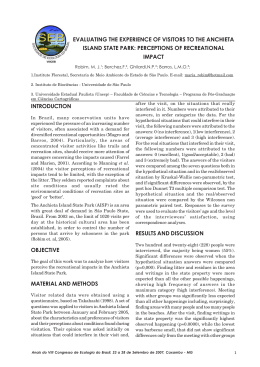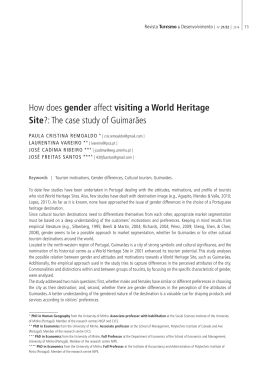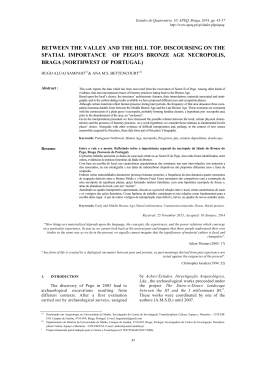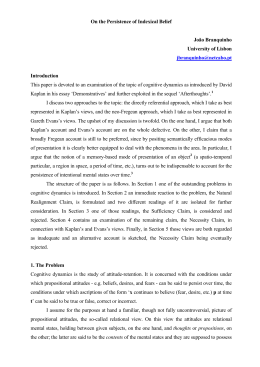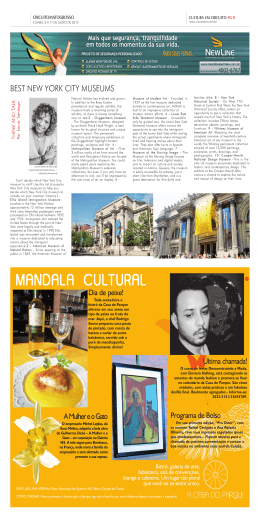___________________________________________________________________________ Journal of Religious Culture Journal für Religionskultur Ed. by / Hrsg. von Edmund Weber in Association with / in Zusammenarbeit mit Matthias Benad Institute for Irenics / Institut für Wissenschaftliche Irenik Johann Wolfgang Goethe-Universität Frankfurt am Main ISSN 1434-5935- © E.Weber – E-mail: [email protected] ___________________________________________________________________________ No. 69 (2004) Alawi Syncretism Beliefs and Traditions in the Shrine of Hüseyin Gazi By Hüseyin Türk Numerous regional and descriptive studies have been made on beliefs and traditions related to shrines. The present study is a scientific outcome of a visit to the shrine of Hüseyin Gazi with a group of Alawi visitors from Divriği. Although the visitors knew very little about Hüseyin Gazi’s historical personality, they carefully practiced all traditions and customs in the shrine. These beliefs and practices descending from their ancient forms of beliefs will provide direct data on development and the origins of their religion. Hence, in this study, on the beliefs and practices held in the Shrine of Hüseyin Gazi visited by Alawi disciples, we expect to reach certain clues to denote that Alawism is a syncretic belief. Introduction Religious Anthropology studies the origins, evolution and functions of religions. The discipline researching religious beliefs and rituals comparatively with cross-cultural perspectives tries to enlighten the belief world of the mankind. Religion, as a term, can be defined as “believing as well as worshipping to the supernatural powers and/or beings by the individual who are emotionally or consciously devoted to them” (Örnek 1988: 127). There have been a number of theories so far which try to bring an explanation to the origins and the evolution of religion. In these theories, Fetishism, cults of nature, animism, Totemism, dynamism, Manism, magic, polytheism, monotheism as well as certain physiological phenomena have been particularized as evolutionary stages and forms of belief (EvansPritchard 1998: 124). All of these theories have the perspective of so called “progressive” and / or “unilinear” that maintain a religion which has reached ongoing stages and that communities which have developed from primitiveness to civilization. They argue that there 2 has only been one single line of progress, and all of the communities are bound to go through the same evolutionary stages. Controversial data obtained from the researches made recently on primitive communities in connection with the proposed evolutionary stages seem to be the leading factor in failure of such theories. Now, as it is a known fact that even primitive communities had belief in a single God as the “creator” and the “protector” (See Malinowski 1990: 12-13; Evans-Pritchart 1998: 122) which proves that unilinear evolution is no longer valid and all the societies have not evolved through identical stages but each community must have its particular form of cultural change (See Steward, 1955: 15-18). Like each society and culture, Anatolian alawies must have particular origins and historical backgrounds on which their religions have been based. Thus, Anatolian alawism has come to these days following a peculiar line. Their beliefs, traditions and rituals descending from their former religion seem to survive in their life after adherence to Islam. These beliefs and practices descending from former religion providing direct data on developent and the origins of their religion have shown themselves. Particularly in shrine worship. Hence, in this study, on the beliefs and practices held in the Shrine of Hüseyin Gazi among a number of other vowing places in Divriği-Sivas, frequently visited by Alawi disciples, we expect to reach certain clues to denote that Alawism is a syncretic belief. Alevilik senkretik bir inançtır. The presence of various elements of ancient beliefs in shrine beliefs of Alawies in Divriği indicates that Alawism is a syncretic belief. There is not any scientific and extensive research about Hüseyin Gazi Shrine. For this reason, we studied the traditions and beliefs related to Hüseyin Gazi Shrine which are usually visited by Alawi people. The method of investigation used for this study is fieldwork. In accordance with this method we joined in a group of Alawi visitors, observed them and had interviews with them in the shrine. The aim of the this study is to examine and explain the beliefs and the traditions of the Hüseyin Gazi Shrine related to Alawi Syncretism. Alawi Syncretism A great deal of research on Anatolian Alawism has been done since1980. Among these researches, many views on the origin of Alawism have been expressed. Some of the views defend that Alawism is an Anatolian Islamic sect originated from Shiism, (Fığlalı, 1990; Selçuk and ark.,1991; Avcıoğlu, 1981; Kehl-Bodragi, 1991) and also some of the views stress that Alawism is an Anatolian religion (Bozkurt, 1990) and a populistic Islamic faith (Burhan, 1990). On the other hand, some of the views defend that Alawism is Ali’s supporters’ philosophy of life and a political manner (Zelyut, 1990). However, a prevalent view is that “Alawism is a syncretic belief”. This view is also defended by the scientists doing research on Alawism (See. Melıkoff, 1994; Ocak, 1990; Şener, 1997; Birdoğan, 1995). According to Şener, Alawism is a life style, which is not a racial but a social one. Alawism has three sources: 1-The injustice act treated to the Saint. Ali by not accepting him as a Caliph, 2-The ancient Turkish Beliefs, 3-The ancient Anatolian civilisations (1997: 38-40). To Ocak, Alawism is a mixture of belief, of which origin goes back to the ancient times. It is syncretism shaped in time and space by many religious, political, socio-economic and cultural factors extending from the oldest periods of the Turks (1990: 20-25; 1983). According to Birdoğan, who states that Alawism is an original belief and a life style which is the mixture of Turk-Oguz beliefs and Islam, there are close connections and similarities between the Shamanist belief and Shaman rituals of Turkish clans and those of Alawis (1995: 449-487). 3 According to Melikoff, who is famous for his studies on Alawism and points out that Alawism is a rich mosaic of belief and a mixture of beliefs, and gives certain examples related to the subject (See 1994: 24,31,37,43,44, 129); Turkish people have given allegiance to a number of religious along centuries... Initially Turks were Shamans; today there are Shaman Turks in Siberia and the Middle Asia. These Shaman Turks worshipped the Heaven God and the forces of nature. Also important are Melikoff’s comments, who argues that there are close similarities between the ancient beliefs of Turks and those of Alawies (1994: 17): “A mosaic of beliefs and religious syncretism forms the essentials of Bektashi-Alawism. Saint Ali (Caliph Ali), highly respected by them is in fact no one but the God of the Heavens of Turks”. When investigating the details, Ali belief is, in fact, the divinity of sun. Ali is identified with the sun. So, Alawis pray to the sun while rising in the morning. Vowing Places and Ancestor Cult In many places of Anatolia, there are a lot of shrines and vowing places where are visited mostly by Sunnis and Alawis. Apart from visiting the shrines, Sunnis worship in diverse forms, such as performing ritual prayer (the namaz), fasting, pilgrimage, and giving zekath, which are indicated in the Koran and applied by the Saint Mohammed. Visiting the shrines has a second place among their worshipping. In fact, mosques are their actual place of worship. The principal forms of worship of the Alawis, who do not go to mosque because of the fact that the Saint Ali was killed in a mosque while praying, are to visit the shrines and vowing places after the cem ritual. Thus, the Alawis’ actual vowing places are the Cem houses and the shrines. The fact that there are a great number of shrines and vowing places in Alawi regions than that of Sunnis justifies this statement. Today, beliefs and traditions performed at vowing places have commonly survived in rural regions in Turkey. However, there is no scientific and detailed research on this subject. So far, only local studies, such as description and collections have been made. The shrines, sacred stones, sacred rocks, sacred great trees and sacred water fountains are visited as vowing places by Alawies. However, the most visited vowing place is the shrines in the rural region of Turkey. People believe that there is a grave of a Saint in the shrines. There are different definitions about “vowing” although many of these share approximately similar points. Örnek’s definition (1973:11) as follows is a good example: “ Vowing includes things such as fasting, sacrifice, food and objects which are dedicated to temples, shrines and Saints by peoples who hope to realize their wishes such as cure of an illness, overcoming bad and difficult situations, giving birth to a child (especially a boy) and getting married, etc.” There are different sorts of vows such as reading Koran, performing ritual prayers (the namaz), buying new clothes for a poor person, delivering various foods, lighting a candle, putting a Turkish flag on a grave in the shrine, tying down a rag to anywhere in the shrine (Köksal 1986:153), sticking a stone on the wall, putting a toy baby on the grave and sacrificing. One of the most common vows is to sacrifice an animal (lamb or sheep, etc) (Cinlioğlu 1961: 5202-5203). Sacrifice, an important section of the worship, is generally dedicated in the presence of god to make peace with supernatural powers and to thank them for their blessing (Örnek 1988: 87-88). Vowing places are visited by the people to make wishes which are beyond their power. They believe that their wishes should be realized with the help of a holy person in vowing places 4 and dedicate various vows in order to have their wishes come true. Shrines are the most widely known and visited in vowing places. Shrines have been built for holy people as well as religious people, martyrs of Islam and the heroes in battles. In time, shrines have been transformed into sacred places which have frequently visited by the public. People have the belief that every one of these persons are Saint and that shrines are sacred places. In general, while visiting shrines people do not want anything from Saints. However, they tell their secrets and pray to God in the presence of Saints. Saints are believed to have some supernatural powers such as walking on the water, understanding someone’s mind, going suddenly to distant place, treating incurable patients, etc (Köksal 1986:227). Shrine visiting have came from the ancestor cult and Shamanism, the old religion of Turkish communities, which also survives nowadays (See İnan 1952: 19-30 and Köksal 1986: 229230). Şamanizm ile atalar kültünün birbiriyle yakından ilişkili iki inanç biçimi olduğu da bilinmektedir. The recent Mongul writings demonstrate how the first worshipping to the ancestor brought about the Shamanism or the fact that Shamanism came into existence with worshipping different ancestors of the tribe (See Roux, 1999: 190). To the ancient belief of Turkish communities, the life continued even after death and the spirits of ancestors remained on the earth affecting the living ones either in positive or in negative sense (Örnek 1971: 23). As a result of this belief, there have appeared such prayers as worshipping the dead and other practices originating from the piety towards the ancestors in accordance with the dead cult. Although the dead cult was applied with the whole community, certain identities stood out on account of their social tasks or religious eminence (Roux 1999:189-190). The fact that such identities, even a long time after their death, remained venerable in public, thus earning them a position worth praying, sacrificing and worshipping gave birth to Manism (ancestors cult). In Anatolia, the graves of religious leaders, war heroes, saints and/or certain persons respected as wisemen are made into shrines visited. Several Islamic and magic beliefs and practices coexist in the ancestors’ cult. Their ancestors were of great importance and respected in ancient Turkish community (Bkz. Araz 1991:76; Kalafat 1999: 70-71; Ocak 1983:44). They used to build a tomb so called “kurgan” above the ancestor’s grave and sacrificed to please their spirits in rituals on certain days of the year (İnan 1986: 10; Ocak 1983: 45-47). It goes without saying that ancestors’ cult had a privileged place among the beliefs of ancient Turkish communities. It is acknowledged that shrines involving the sacrifice and certain beliefs along with other related customs date back to the Shamanism and the Manism (İnan 1986: 10,106,189; 1952:1930; Köksal 1987:229-230). Roux (1999: 190) argues that recent Mongol writings maintained the idea that Shamanism developed from worshipping various ancestors of the tribe. As mentioned by İnan (1986: 105-106), sending for the spirit of the great ancestors of each tribe at Shaman rituals as well as praying and sacrificing for them on account of protection against evil spirits denote that the Shamanism and the Manism co-existed in Turkish communities. The Ancestors cult can also be seen in many ancient civilizations apart from the Turks. In ancient Greek, each site had its own protector God. In the Romans, there were protector fairies, called “Lar” (Estin ve Laporte, 2003: 210) The benevolent Maneses were also protector ancestors. According to the Roman belief, the God, Jupiter, is far away the earth, however the Penaters (the protector spirits of the house) are more close to the family. The God, Mars, is in the heavens; the Maneses (spirits of the dead) are close to family. Worshipping ancestors, which is the main charecteristics of the ancient Iran culture, was transformed into the belief of Fravashi (protector spirit; ancestor spirit) in Zoroastrianism (Dinler Tarihi Ans., cilt 1,1999: 22-23, 147)..Worshipping ancestors is a common belief in Japanese culture. In Japanese belief, there are lots of gods (kami). Some of the kamis bring 5 life to the nature, sky, trees, stones, etc. In Shintoism, there are about eight million kamis (Dinler Tarihi Ans., Cilt 1, 1999: 157-158). According to Chinese belief, the heavenly spirits of ancestors know everything happening on the earth. They are presented sacrifices... (Ocak, 1983: 46). Hüseyin Gazi Shrine Divriği has been considered to be an important center to settle and have a long historical past due to the fact that it was under the sovereignty of Romans, Byzantine, Seljuk and Ottomans in the history. Today there are many shrines in Divriği where have been visited by Alevies: Hüseyin Gazi, Seyit Baba, Hasan Paşa, Gazi Baba, Ali Baba, Sultan Melek, Kara Yağıb, Garip Musa. The most visited shrine is Hüseyin Gazi Shrine which is at the top of the Iğımbat Mountain in Divriği. There isn’t any shrine belonging to the Sunnis in Divriği. Sunnis visit mostly the shrines belonging to Alawis; however, in these shrines, right along with wishing and vowing they perform the forms of Islamic worshipping such as fasting, praying, and reciting prayer from the Holy Koran. According to the written sources and legends, Hüseyin Gazi was the father of Seyit Battal Gazi who was born in Malatya (See Özen 1987:146-147 and Araz 1956: 48). It is believed that Seyit Battal Gazi has also several other graves in more than one place. In Ankara and Çorum, Afyon, Eskişehir, Kayseri, Malatya and Tunceli there are graves that are believed to belong to Hüseyin Gazi and Seyit Battal Gazi. (Aslanbay, 1953; Özen 1987:147 and Tanyu 1964: 205,260). Hüseyin Gazi and his son Seyit Battal Gazi are famous Turkish commanders who have aimed to spread Islamic religion all over the world. Huseyin Gazi is a famous Muslim hero who strives for spreading the Islam and dies while fighting for the sake of the religion. (Aslanbay1953:44-45). The names of both persons and the legend of “Battal Gazi” are very common and familiar in the world of all Turks. The books concerning the legend of Battal Gazi have been read and adopted by all Turks in the past centuries. According to the legend, Hüseyin Gazi takes an important role as an initiator of Seyit Battal Gazi in Islamic battles. That Hüseyin Gazi is murdered by Mihriyayil who was the prince of Mamuriye (Ankara) castle and his soldiers were the creator of Seyit Battal Gazi’s Islamic acts and adventures (Köksal 1984:93). The lineage root that is hung on the entrance door of Seyit Battal Gazi Shrine in Seyit Gazi indicates that their lineage comes from the Caliph Ali (Aslanbay 1953:43). The Shrine consists of a wide courtyard surrounded by walls, a large hall and a small room. Hüseyin Gazi’s grave is about 70 cm. in width and 1.5 m. in length. Its height is 70 cm. from the ground (figure 1). One day the upper part of the grave was covered in order to preserve it. However, the next day it was found opened. Thus it has been commented that Hüseyin Gazi had not wished his grave covered, and eventually it has been left open and only surrounded by the walls around the grave. In addition, there is an iron gate opening to the inside from the courtyard. The large hall is for resting visitors and the small room, though used for cooking sacrificed meat, is really multifunctional. There are three more graves in front of the building. These graves are considered to belong to the soldiers of Hüseyin Gazi. The grave of a historical character that people believed was a saint has usually been found at a few different places. Many different legends have been told about saints at these places, but the majority of these have many similar points. In Divriği many different legends about Hüseyin Gazi have been told. But the majority of these have many similar points. According 6 to these legends “In a war in Divriği he had defeated three fourth of the enemy forces by himself with his sword. Being forgotten in the war he had stopped to pray (the namaz). In this time one of the opponent soldiers had come to closer to him from behind and decapitated Hüseyin Gazi with his sword. Hüseyin Gazi did not like the place where he had become martyr and he was moved to Iğımbat Mount he lies now with his head.” (Dumluca 1973:1718 and Özen 1987:148-149). The variations of this legend are told by the visitors of the shrine. Information on the Visitors The visitors attending the sacrifice ceremony at the shrine come from the villages of Divriği and the district of Hacı Kumru, located at the foot of Iğımbat Mountain. The information received from the visitors through interviews and the beliefs and traditions practiced by the visitors of Hüseyin Gazi Shrine are as follow. The shrines are usually visited to find a way to the problems which people couldn’t solve on their own or to cure illnesses which are incurable or need a long period of medical treatment. The majority of visitors are older. Their educational level is fairly low. Although the visitors do not have enough information about the saints they often visit the shrine where his grave is found and practice beliefs and traditions related to the shrine. The total number of visitors attending the sacrifice was 26. The number of the female visitors was 12 (46.2 %) and that of men was 14 (53.8 %). In addition, many children were brought to visit the shrine. 1 person (3.8 %) was under the age of 20 , 6 persons (23.1 %) were between 20-29, 8 persons (30.8%) were between 30-39 and 11 persons (42.3%) were below the age of 40. The education level of the visitors was quite low. 12 of the visitors were illiterate, 10 had graduated from primary school and 4 had graduated from high school. These data show that visitors to the shrine are mostly average age men and women or over this age and on the whole with a low educational level. The visitors did not know much detailed information about the Hüseyin Gazi. Only 6 of the 26 visitors knew about the personality of Hüseyin Gazi and his legend. Only one had collected information and done research on Hüseyin Gazi. The remaining 20 persons had only heard about Hüseyin Gazi being “a saint” and a Turkish “commander who died in a battle for Islam”. Although the visitors did not have sufficient information about Hüseyin Gazi, they often visited the shrine. Except for 3 (11.5 %) of the visitors, most pointed out that they often visited the shrine. The majority of the visitors believe that all of their wishes which they did at Hüseyin Gazi’s shrine have come true. While 16 persons (61.6 %) pointed out that all of their wishes were realized, 9 (34.6 %) of the visitors pointed out that some of their wishes were realized. One (3.8 %) visitor had wished for the first time. This information denotes that majority of visitors, though lacking of any knowledge about the historical identity of Hüseyin Gazi, do come round here to visit the shrine, which proves that the belief of shrines has descended throughout generations and the people fulfill the requirements of belief and traditions related to shrines without questioning. Beliefs and Traditions As with other Alawies in Turkey, it is also true for those living in Divriği that shrine visits rank next to the main prayers, collective worship (ayin-i cem), in importance and in frequency. Shrine visiting includes ceremonies, rituals, traditions and some prohibited 7 behaviors. The beliefs, traditions and rituals that are practiced in Huseyin Gazi shrine are presented below: Respect to the Tomb Before entering the courtyard, the gate at the entrance is kissed by all visitors. All the visitors kneel down and turn around the grave with this position three times by kissing the grave (figure 2). The graves that are believed to have belonged to the soldiers of Hüseyin Gazi are kissed by the visitors as well. Though kissing the gate and grave stones is a custom originating entirely from the respect for Hüseyin Gazi and his soldiers, it might as well be considered as a contact magic. These customs can be regarded as beliefs based on the contact principle of the sympathetic magic established on the supposition that super natural power believed to belong to Hüseyin Gazi might have permeated to living things and/or inanimate things in vicinity of the shrine (See. Santur 1998:435). As for walking around the grave this is a practice fulfilled during the funerals in Shamanism. Sagay Turks attending such ceremonies including funeral feast, used to walk round the grave calling out to the deceased three times in their words “You return to the real world, and we are turning to God” (İnan 1986: 186). Also in funerals of Göktürk communities, close relatives of the deceased would ride seven tours around the tent of the corpse (İnan 1986:177). Wishing The way of wishing for longings is to express it loudly or silently to Hüseyin Gazi, following a prayer process; however, there are some others who wish for their desires in writing or lighting candles. Lighting candles is the most widespread way for making wishes maintained in most shrines in Anatolia. It is believed that desires will come true while the sins fade away as the candles burn out. Also in shrine of Hüseyin Gazi some visitors can be seen making wishes by lighting a candle in the large hall (or resting room). Much as lighting candles and making wishes with candles are such practices that can happen more frequently during church visits and rituals by Christian disciples, it is also a common practice to light candles in seeking omen in major rituals held by a Muslim Shaman. (See. İnan 1986:109, 110). Some visitors may be seen making wishes in writing directly on the wall in a chamber which shows that they believe Hüseyin Gazi can hear them and see them. Vowing Vowing is the custom of promising solemnly in the shrine to do one thing in return for achieving or obtaining a wish. Much as there are various vows such as praying in the shrine, fasting, giving away food, helping the poor, sacrificing animals and climbing on necked foot up to the hill where the shrine is, the most essential and the widespread one is to vow to sacrifice. Sacrificial Vows İnan (1986: 97-98, 100) points out that rituals were bound to involve sacrificing according to the Shaman tradition in ancient Turkish communities. To him sacrificial means offered to supernatural forces can be classified in two main groups, namely: bloodless sacrifices and bloody sacrifices. 8 Bloodless sacrifice involved libation, tying rags on to trees and the Shaman drum, spilling plant oil and wine on the fire. Of all these sacrificial means, such animals called as libations, ıdık or ıduk were the most important ones. The ıdık were certain animals liberated as a present to holly spirits. These animals were not sheared or loaded with burdens; nor were they milked. The term “ıdık” meant an animal released free as “a thanks giving” to God. This animal was made to wear an earring as a means of identification. This libation would always be one of the most valuable sacred blessings earned by that tribe with their own efforts. Offering libations to holy spirits is a universal custom experienced all over the world. (İnan 1986: 98,100, 107). Also practiced among other bloodless sacrifices in the shrine of Hüseyin Gazi are spreading coins on the grave, supporting the poor, tying rugs in addition to giving away various foods as libation. Following the realization of their wishes some visitors deliver biscuits, grapes, roasted chickpeas and some local foods to the visitors to fulfill their vows. It is believed that the person who eats all of these foods should be healthier and increase the power of religion. Some visitors throw coins on the grave of Hüseyin Gazi. Hence, they believe that their wishes would be realized. Before these coins were being inserted into a money–box; however, the money-box was stolen about 5-6 years ago. Ancient Turkish communities would sacrifice to please their ancestor’s spirits, supernatural forces and God. No rituals would be held without a sacrificial feast. Male animals were the most welcomed among other bloody sacrifices. According to the aim, Örnek divides sacrifice into the four groups (1988: 87-88): 1-Sacrifice offered to God for wishes, 2-Sacrifice offered to thank God, 3- Sacrifice offered to God to forgive a sin or a fault. 4- Deservetion sacrifices that are offered to the supernatural powers following the first harvest of the year. Erginer (1997: 142) argues that sacrificial vows are of thanksgiving character offered to express one’s gratitude for a wish granted. It differs from others in that sacrificial vow is rendered not in advance but on realization of the wish. This kind of sacrifice takes place mostly in shrines and is carried out by the vower on being granted his wish. Also in the shrine of Hüseyin Gazi there are sacrificial feasts rendered on realization of wishes and the meat is offered to the guests. If one of the visitors offers a sacrifice for a wish that came true, he sacrifices and cooks “pilaf with meat and boiled wheat” with meat of the sacrifice in huge boilers on the skirts of Iğımbat Mountain . Then he invites his close relatives and neighbors to join in the feast. Before being sacrificed, the animal is made to touch the grave of Hüseyin Gazi on its ear of the sacrifice is touched the grave of Hüseyin Gazi. In fact, it is believed that sacrificing should happen near the shrine, but there is no water there. For this reason sacrificing action inevitably takes place on the skirts of the mountain. Thus, it is indicated that the sacrifice is killed for Hüseyin Gazi. This feast resembles the “dead feasts” rendered in ancient Turkish communities. It was aimed with the sacrificial feast offered directly to the spirit of the deceased or to those of the ancestors that they should stay safe against curses by these spirits. The ceremonies and feasts held in honor of the dead today are nothing but the evolved version of these ancient feasts (See İnan 1986: 189, 192; 1952: 21, 24). Performing Ritual Prayer and Fasting Certain beliefs and customs related to the vowing in the shrine are entirely of Islamic nature. For instance very few visitors pray, fast or perform ritual prayers (the namaz) for God. Ritual 9 prayers and fasting of these three forces of worshipping are fulfilled by only Sunni Muslims. It was observed that a few Alawian visitors fasted and prayed as vowing. Climbing to the Top on Barefoot It is also interesting that some visitors whose wishes were realized walk barefoot to the top of Iğımbat Mountain, which is not only a common but also a demanding way of vowing practiced in the shrine of Hüseyin Gazi. Vowers whose wishes have been granted climb to the Iğımbat Mount a half hour along a path of thorns and rocks despite the eventual risk of bleeding feet and bruises. Various Cults of Nature Rocks, boulders, trees, running water and mountains are regarded as sacred in the shrine tradition of the Alawies living in Divriği. These are considered to be the remains of ancient Turkish beliefs reaching to this day (See Kalafat 1999; Araz, 1991; Ocak 1983; İnan, 1986). In ancient Turkish communities, it was believed that almost every creature in the nature had secret powers. Thus, they regarded alive and sacred such things as mountains, hills, rocks, boulders, trees and water and held various cultic ceremonies for them (See Ocak 2000:47-48). In fact, the religious beliefs originating from Anatolia were some what of natural character considering the elements of nature as sacred beings; these people would furnish them with divine features and would even worship them. People of certain nations living in ancient Anatolia had the reflections from the natural religion (Dinler Tarihi Ans. Vol.1: 101-103,106). Cult of Mountain The reason that the shrine of Hüseyin Gazi is situated on the top of a high mountain is more related to the cult of mountain. It is not merely by chance that major temples and shrines in Anatolia were built high on the acme of high mountains. Ancient Turkish people believed that mountains were of heavenly nature pertaining to God. Cult of mountains among the Shamanist Turkish communities is directly related with the belief of “the God of Heavens” (Gök Tanrı). Sacrifices were offered to “the God of Heavens” in the mountains regarded sacred. (See İnan 1986: 5, 9,48-49) Khuns, Göktürks and Uygurs buried their corpses on top of the mountain. Ancient Turkish people had such attributes regarding these sacred mountains and peaks that they were compassionate living things which can see, hear, speak and marry. These beliefs appearing among the Shamanist Turkish communities seem to involve the remains of the ancient primitive animism belief (See İnan 1986:50, 51; Araz, 1991: 50). Cult of Rocks and Stones Rocks and stones were among natural elements regarded sacred by ancient Turkish communities. A kind of stone so called “yada stone” was attributed with the ability to start the rain (Kalafat, 1999: 41). In the legends of creation rocks and stones are referred as powerful and mighty sacred beings which redeem, save and shelter the community (Araz, 1991: 48). Among other beliefs and customs related to the shrine of Hüseyin Gazi are those associated with rocks and stones which are attributed with intermediary hidden powers to help recover one’s health, make him happy and successful. Such hidden power and might are believed to originate from the proximity of the shrine of Hüseyin Gazi. It is also believed that this virtual power is supposed to have permeated into the animate and inanimate things in the vicinity of the shrine. Moreover there appear to be certain customs and beliefs aiming to make use of this 10 power, which can be considered as beliefs and practices based on the “contact principle” of the sympathetic magic or simply a sort of augury. After the “pilaf with meat and boiled wheat” had been cooked and eaten, the visitors set out for the shrine, climbing Iğımbat Mountain. The holes on the rocks that exist on the lower part of the shrine are believed to be evidence of Hüseyin Gazi’s horse. Some visitors lie on these rocks in order to get rid of their back pains (Figure 3). Some visitors achieve to pass through the hole called “the Sin Hole” (figure 4). The hole is situated on the rock outside of the shrine. If one achieves to pass through the hole he/she believes that he/she has not sinned or that his/her sins should be forgiven. If one is not able to pass through the hole it is believed that he/she has a lot of sins, and for this reason he/she should sacrifice an animal. When some little stones are stuck on the grave of Hüseyin Gazi, wishes are made at the same time by the visitors. They believe that if stone remains on the grave their wishes would be realized , and if it falls off the grave their wishes would not be realized. The Cult of Trees Alawies in Divriği, attributing sacred qualities to the trees and waters with a proximity to a shrine tie rugs to these trees (See Türk 1991: 118); on the other hand, there happen to be no tree or water nearby the shrine of Hüseyin Gazi. For this reason, the visitors tie rags to the main gate of the shrine. While going out of the shrine, the visitors tear a part of their own clothes and tie it on part of the gate courtyard. They believe that their sorrows and troubles would remain there. Rags tied before to this gate are also got by some visitors. These rags are touched to their own face. Thus they believe that their illnesses would be cured. Moreover parents whose child is sick hang a part of the child‘s clothing on the rope in the large room. Thus they believe that their child will be cured. In addition to be a bloodless sacrifice, the custom of tying rugs on trees is related to cult of tree which was wide spread among the ancient Turkish communities. İnan (1952: 25) points out that tying rugs onto graves and trees is one of the oldest vows and this vow is offered to the God so called earth-water. He maintains that earth-water spirits are protective and they are rather contented. Similarly Kalafat (1999: 29) proposes that tying such things as rugs and ropes to the wish-tree and certain places in the shrines means to shelter that shrine with the hope of finding relief there. Dynamism In addition to certain wishes of the people, wishes related health also emanate from the intention of taking advantages of spiritual powers, believed to be emitted by the saint. Basic motive for the belief is the wish to gain directly from the spiritual power of the saint (Santur 1998:435). This belief resembles much to that of dynamism enjoyed by most of the primitives. Dynamism is the belief motivated for attaining the dynamic and mystical power believed to be existed in certain things, plants, animals and human beings. This super natural force occurring with some persons and parts of nature is called “mana” in the native words (Örnek 1988: 29-30). Eating Soil and Laying Children on the Grave 11 It is quite possible to consider that such practices as eating soil, laying the children on the saint’s grave or having them sleep in the shrine might be linked to the desire to make use of this supernatural power which is supposed to exist in the shrine of Hüseyin Gazi. According to this belief; the soil on the grave of Hüseyin Gazi that is called “cüher” is chewed by visitors. Moreover, some visitors take this soil with them for their relatives and neighbors. They believe that the soil consists of religious powers and, that it is good for mental illnesses. Moreover children are made to lay on the grave of Hüseyin Gazi by his/her parents (figure 5) The reason of this is to thrust their children to Hüseyin Gazi. Thus they that believe their children will get rid of illnesses and bad tempers. Sleeping in the Shrine Before one goes into the large room which is also used as a resting room, the threshold of the gate at the entrance is kissed by all visitors. Some of the visitors lay on beds in the room and put forth great effort to sleep there. They believe that dreams they will see during their nap would come true (figure 6).Those intending to sleep in the shrine believe that Hüseyin Gazi’s spirit will let them to see some events at future in their dreams, enhance their strength of belief and get rid of their complaints related to health, especially to morale health. This belief can be linked to the wish to make use of the prophetic gift and curative power attributed to Hüseyin Gazi. Conclusion Conclusions which are reached in terms of the data related to the beliefs and traditions of the visitors in Hüseyin Gazi Shrine are as follows: 1-If the shrines did not have any function, they would not survive today. The shrines have played an important role as a hope and psychotherapy for the incurable illnesses and difficult statements. Another factor in the survival of shrines in Turkey is that Alawies have used shrines as a worship place. Alawies do not go to mosques which are used by Sunnis to perform the ritual prayers (the namaz), and even if they go to a mosque they are usually insulted by the Sunni people. In this sense, shrines function as a worship place. An important part of the worships of Alawies in Divriği has consisted of visiting shrines, fulfilling beliefs and traditions related to shrines and sacrificing in the shrine. 2- It is well known fact that communities converted because of certain reasons from their centuries-old-religious to another one wouldn’t renounce their existing beliefs as they were meanwhile amending some others according to their new religion. Indeed, some Turks couldn’t totally depart from their old belief and traditions after becoming Muslims. Modifying and adopting all these beliefs and traditions into the new religion, they added them to their lives. Today the beliefs and practices in relation to the shrine of Hüseyin Gazi are the remains of such forms of the ancient belief whose original forms have been forgotten and the practice areas have been changed into presently perceived forms. Yet, the forms of the ancient belief don’t survive in all sections of the society in Turkey today. The group where these beliefs mostly occur is the Alawies sect that keeps them most vividly and most frequently. It is the shrines that are the most appropriate places where the Alawies keep alive the remains of their original beliefs. 12 3- Among beliefs and customs observed in the shrine of Hüseyin Gazi visited Alawies dwelling in the town of Divriği, are such practices as ritual prayers (the namaz) and reading out verses from the sacred Koran that are of Islamic nature performed more generally by the Sunni visitors. Apart from these practices, other beliefs and customs are the remains of ancient Turkish beliefs beyond Islamic faith and performed more often by the Alawies. 4- As a result of evaluations of beliefs and customs practiced by Alawies in the shrine of Hüseyin Gazi, the similarity between the belief of the God of heavens and the divine attributes of the Saint Ali, the ancient forms of beliefs and traditions, such as ancestors cult (respecting to the spirit and the grave of ancestor, visiting the grave of ancestors, dead feasts, turning around the grave of ancestor, bloody and bloodless sacrifices), various cults of nature (the cult of mountain, the cult of stone and rock and the cult of tree), Shamanism, Dynamism, several magical practices, have been revealed. The majority of these beliefs and traditions are also seen in ancient Turkish communities. However, dynamism and various magical practices are primitive forms of belief related to origin of religion. Moreover, Some Islamic practices and the forms of Christian belief have been found. These findings demonstrate that Alawism is formed with different ancient beliefs, mostly the ancient beliefs of Turks, and combines these beliefs with Islam. And these findings verify the view of “Alawi Syncretism” in that Alawism is a synthesis of beliefs. References Cited Araz, Nezihe. 1958. Anadolu Evliyaları. İstanbul. Araz, Rıfat. 1956. Harput’ta Eski Türk İnançları ve Halk Hekimliği. Ankara: Atatürk Kültür Merkezi Başkanlığı Yayını. Arseven, Veysel. 1956. “Aşık Paşa Türbesi”. Türk Folklor Araştırmaları. 4/ 85. Aslanbay, Muhittin. 1953. Seyit Battal Gazi’nin Hayatı ve Bazı Menkıbeleri. Eskisehir. Avcıoğlu, Doğan. 1981. Türklerin Tarihi. İstanbul : Tekin Yayınevi. Birdoğan, Nejat. 1995. Anadolunun Gizli Kültürü Alevilik. İstanbul: Berfin Yayınları. Bozkurt, Fuat. 2000. Çağdaşlaşma Sürecinde Alevilik. İstanbul : Doğan Kitapçılık A.Ş. 1990. Cinlioğlu, Halis. 1969. “Tokat’ta Ziyaret Yerleri ve Usulleri”. Türk Folklor Araştırmaları. 12/ 235. Dumluca, Halil. 1973. “Divriği’de Yatırlar ve Evliyalar”. Sivas Folkloru. 9. sayı. Erginer, Gürbüz. 1997. Kurban, Kurbanın Kökenleri ve Anadolu’da Kanlı Kurban Ritüelleri. İstanbul: Yapı Kredi Yayını. Evans-Prıtchard. 1998, İlkellerde Din. Ankara: Öteki Yayınevi. Fığlalı, E. Ruhi. 1990. Türkiye’de Alevilik Bektaşilik. İstanbul : Selçuk Yayınevi. İnan, Abdülkadir. 1952. “Müslüman Türklerde Şamanizm Kalıntıları”. İlahiyat Fakültesi Dergisi. IV. Cilt. Ankara. İnan, Abdülkadir. 1986. Tarihte ve Bugün Şamanizm. Ankara: T.T.K. Yayını. Kalafat, Yaşar. 1999. Doğu Anadolu’da Eski Türk İnançlarının İzleri. Ankara: Atatürk Kültür Merkezi Başkanlığı yayınları. 13 Kehl-Bodragi, Kristina. 1991. “Alevilik Üzerine“. Cem. 6. sayı. s.21-24. Köksal, Hasan. 1984. Battalnamelerde Tip ve Motif Yapısı. Ankara Köksal, Hasan. 1987. “İzmir ve Çevresinde Yatırlar İle Bunlara ilişkin olarak yaşayan İnançlar”. III. Milletlerarası Türk Folklor Kongresi Bildirileri, Gelenekler Görenekler ve İnançlar, IV. Ankara: M.İ.F.A.D. Yayını. Küçük, Abdurrahman. 1982. “Tercan ve Çevresinde Adak Yerleri ve İlgili İnançlar”. II. Milletlerarası Türk Folklor Kongresi Bildirileri. Gelenekler Görenekler ve İnançlar. IV. Ankara: M.İ.F.A.D. yayını. Melıkoff, Irene. 1994. Uyur İdik Uyardılar. İstanbul: Cem Yayınevi. Ocak, Ahmet Yaşar. 1983. Alevi Bektaşi İnançlarının İslam Öncesi Temelleri. İstanbul: İletişim Yayınları. Ocak, Ahmet Yaşar. 1990. “Alevilik Bektaşilik Hakkındaki Son Yayınlar Üzerinde Genel Bir Bakış ve Bazı gerçekler“. Tarih ve Toplum. Cilt XVI. 91. sayı. s. 20-25. Ocak, Ahmet Yaşar. 2000. İslam Türk İnançlarında Hızır Yahut Hızır-İlyas Kültü. Ankara: Türk Kültürünü Araştırma Enstitisü Yayını. Oğuz, Burhan. 1990. “Anadolu Aleviliğinin Kökenleri“. Alevilik Üstüne Ne Dediler?. (Ed. Cemal Şener). İstanbul: Ant Yayınları. Örnek, Sedat Veyis. 1973. Budunbilim Terimleri Sözlüğü. Ankara: Türk Dil Kurumu yayını. Örnek, Sedat Veyis. 1988. İlkellerde Din, Büyü, Sanat, Efsane. İstanbul: Gerçek Yayınevi. Özen, Kutlu. 1987. “Divriği Iğımbat Dağındaki Hüseyin Battal Gazi Yatırı İle ilgili Rivayet ve İnanışlar”. Türk Folklor Derlemeleri. Ankara: M.İ.F.A.D. yayını. Özergin, Kemal. 1967. “İstanbul Yatırlarına Dair”. Türk Folklor Araştırmaları. 12 / 237. Roux, Jean-Paul. 1999. Altay Türklerinde Ölüm. İstanbul: Kabalcı Yayını. Santur, Alparslan. 1998. “Eren (Evliya) Mezarları Etrafında Oluşan Şifa ve Sağlık Talebine Yönelik İnanışların Etnolojik Değerlendirmesi”. I. Uluslar arası Türk dünyası Eren ve Evliyaları Kongresi Bildirileri. Ankara: Ervak Yayınları. Selçuk, İ ve Ark. 1991. “Günümüzde Alevilik“. Türkiye’de Alevilik ve Bektaşılik. İstanbul: Hasat Yayınları. Şener, Cemal. 1997. şaha Doğru Giden Kervan, Alevilik Nedir?. İstanbul: Ant Yayınları. Steward, Julian H. 1955. Theory of Culture Change. Urbana: University of illinois Press. Tanyu, Hikmet. 1964. Ankara ve Çevresinde Adak ve Adak Yerleri. Ankara: Ankara Üniversitesi Yayını. Türk, Hüseyin. 1991. “Sultan Melek Türbesi ile İlgili Adet ve İnanmaların İncelenmesi”. Türk Halk Kültürü araştırmaları. Yunus Emre Özel Sayısı. Ankara: Kültür Bak. Halk Kültürünü Araştırma Dairesi Yayınları. Tylor, Edward B. 1920 (1871). Primitive Culture, Researches Into the Development of Mythology,Language, Art and Custom. London: Macmillan and co. Zelyut, Rıza. 1990. Öz Kaynaklarına Göre Alevilik. İstanbul: Ana. Kül. Yayınları. 14 List of the Figure Captions Figure 1: A panoramic view of the Shrine. Figure 2: The women lying on the footprints of Hüseyin Gazi’s horse Figure 3: The People kneeling and turning around the grave of Hüseyin Gazi. Figure 4: A women passing through “sin hole”. Figure 5: A child made to lie on the grave of Hüseyin Gazi. Figure 6: Some of the visitors lying on beds in the large hall. 15 Figure 1: A panoramic view of the Shrine. 16 Figure 2: The women lying on the footprints of Hüseyin Gazi’s horse 17 Figure 3: The People kneeling and turning around the grave of Hüseyin Gazi. 18 Figure 4: A women passing through “sin hole”. 19 Figure 5: A child made to lie on the grave of Hüseyin Gazi. 20 Figure 6: Some of the visitors lying on beds in the large hall. This descriptive writting is so numerous that it can’t listed here. Some of the most important ones is as follows: (Küçük, 1982: 316; Cinlioğlu, 1969:5201; Özergin, 1967:5249; Köksal, 1987: 229; Arseven, 1956:1354; Tanyu, 1964; Araz,1958) In addition on the sacrifice for detailed information see (Erginer, 1997)
Download
